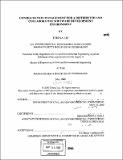| dc.contributor.advisor | Feniosky Peña-Mora. | en_US |
| dc.contributor.author | Liu, Teresa (Teresa Ming), 1977- | en_US |
| dc.contributor.other | Massachusetts Institute of Technology. Dept. of Civil and Environmental Engineering. | en_US |
| dc.date.accessioned | 2005-09-27T19:58:34Z | |
| dc.date.available | 2005-09-27T19:58:34Z | |
| dc.date.copyright | 2000 | en_US |
| dc.date.issued | 2000 | en_US |
| dc.identifier.uri | http://hdl.handle.net/1721.1/9019 | |
| dc.description | Thesis (M.Eng.)--Massachusetts Institute of Technology, Dept. of Civil and Environmental Engineering, 2000. | en_US |
| dc.description | Includes bibliographical references (leaves 104-106). | en_US |
| dc.description.abstract | In the face of changing technology, the world is becoming more global by the minute. This globalization has resulted in dispersed teams and collaborative opportunities, which offer value and depth to projects. Software development also reflects this globalization, as do all the processes involved in software development. It is important to understand these changes and how they affect not only the entire development process as a whole but also each individual part of the process. Configuration management is an integral part of the software development process. In order to perform good software development, it is imperative to understand and be able to implement proper configuration management. Thus, as configuration management is important to software development, it is also important to study the effects of how the changing context of software development toward distributed and collaborative environments affects configuration management. Not only does configuration management influence the transition to this type of environment, it also is quite affected by it. In this thesis, I aim to examine the impact of a distributed and collaborative development environment on configuration management. I will first give an overview of software engineering with respect to configuration management; next, I will provide and introduction to traditional configuration management, and in the following chapter, I will discuss distributed and collaborative configuration management as it exists today. Next, I will provide a case study of the ieCollab project, a project in which developers were dispersed and a great deal of collaboration occurred, and finally, I will discuss the future of collaborative and distributed configuration management. | en_US |
| dc.description.statementofresponsibility | by Teresa Liu. | en_US |
| dc.format.extent | 125 leaves | en_US |
| dc.format.extent | 9498534 bytes | |
| dc.format.extent | 9498295 bytes | |
| dc.format.mimetype | application/pdf | |
| dc.format.mimetype | application/pdf | |
| dc.language.iso | eng | en_US |
| dc.publisher | Massachusetts Institute of Technology | en_US |
| dc.rights | M.I.T. theses are protected by copyright. They may be viewed from this source for any purpose, but reproduction or distribution in any format is prohibited without written permission. See provided URL for inquiries about permission. | en_US |
| dc.rights.uri | http://dspace.mit.edu/handle/1721.1/7582 | |
| dc.subject | Civil and Environmental Engineering. | en_US |
| dc.title | Configuration management for a distributed and collaborative software development environment | en_US |
| dc.type | Thesis | en_US |
| dc.description.degree | M.Eng. | en_US |
| dc.contributor.department | Massachusetts Institute of Technology. Department of Civil and Environmental Engineering | |
| dc.identifier.oclc | 47662779 | en_US |

